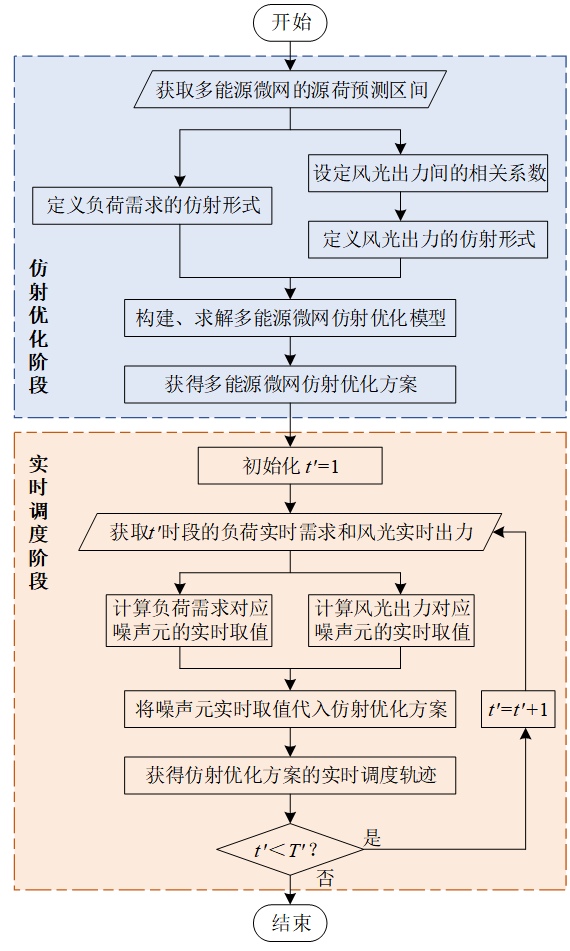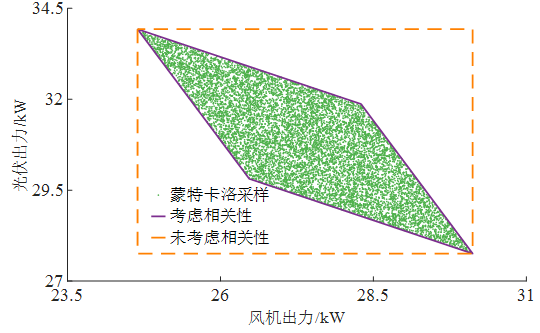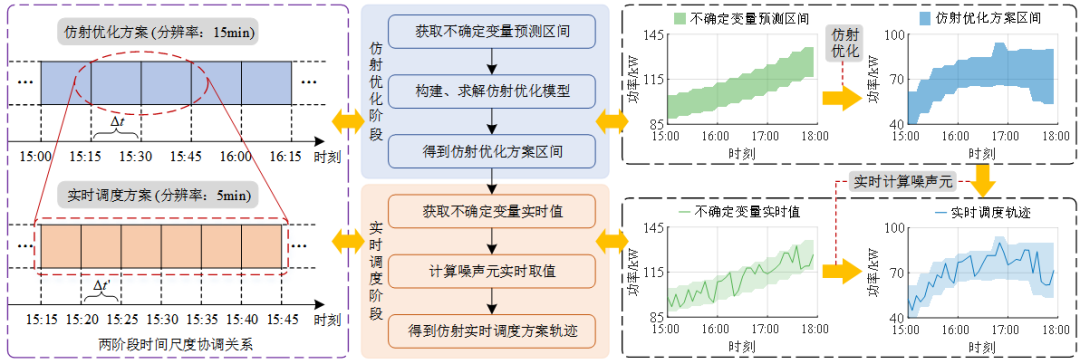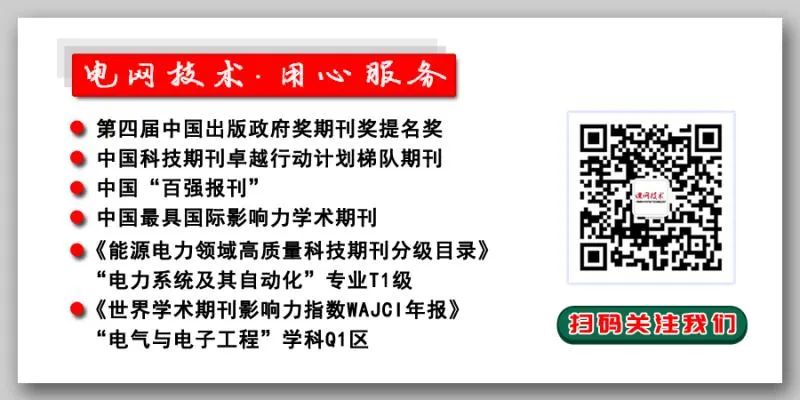



Unlike traditional affine optimization methods where various uncertainties are considered independent, this paper constructs an affine optimization model for multi-energy microgrids that takes into account the correlation of renewable energy output. This model utilizes affine algorithms to describe source-load uncertainty and further employs the Parallelogram Model (PM) to characterize the correlation of wind and solar output, reducing the conservativeness of the affine optimization scheme at the modeling level. The proposed affine real-time optimization dispatching method includes two phases: affine optimization and real-time dispatching. After obtaining the range of the affine optimization scheme for the multi-energy microgrid, real-time dispatching trajectories are extracted from the affine optimization range based on the calculated real-time values of noise elements, enabling the application of affine optimization methods in real-time dispatching scenarios. Simulation results validate that the proposed method can fully account for the dual impact of uncertainty and correlation and effectively respond to real-time changes in source-load. The specific content is as follows:
(1) Affine modeling considering the correlation of renewable energy output.
The affine algorithm represents various uncertain variables in the multi-energy microgrid through a linear combination of central values and noise elements. For the affine model representing the uncertainty of wind and solar output, its central value can represent the predicted value of wind and solar output, while the coefficients of the noise elements can represent the maximum prediction error of wind and solar output.
Due to geographical proximity and similar meteorological conditions, there is a certain correlation between the output of wind turbines and photovoltaics. Therefore, this paper adopts a two-dimensional PM model to describe the correlation of wind and solar output and expresses the PM model in the form of inequality mathematical expressions. Further, the mathematical expression is derived and transformed to explore its fit with the affine model, thereby reconstructing the original affine model representing the uncertainty of wind and solar output to obtain a correlated wind and solar output affine model.
(2) Affine real-time dispatching method for multi-energy microgrid.
The affine optimization scheme is essentially a range of variable adjustments, making it difficult to directly apply in the real-time dispatching phase. To enhance the affine optimization scheme’s ability to respond to real-time changes in source-load, this paper further proposes an affine real-time dispatching method for multi-energy microgrids. The affine optimization method can obtain the central values of decision variables and coefficients of noise elements by solving the affine optimization model. If the specific values of the noise elements in the decision variables are known, real-time dispatching trajectories can be extracted from the affine optimization range.
Based on the above ideas, the affine real-time dispatching method is divided into two phases. In the first phase, affine optimization is performed based on the predicted range of uncertain variables to obtain the range of the affine optimization scheme; in the second phase, the dispatching time interval is first narrowed, and then the real-time values of uncertain variables are calculated to determine the real-time values corresponding to the noise elements of each uncertain factor, which are then substituted into the decision variables in affine form to ultimately obtain the affine real-time dispatching trajectory. The flowchart of the proposed method is shown in Figure 1.

Figure 1 Flowchart of the Proposed Method
(3) Case Analysis and Conclusion.

Figure 2 Output Range of Wind Turbines and Photovoltaics at 12:00
Table 1 Operational Cost Ranges of Different Methods

3)To demonstrate the advantages of the proposed method in the real-time dispatching phase, it is compared with perfect dispatching, MPC, and robust MPC methods. The operational costs and energy deficits of different methods are shown in Table 2.

This paper has not yet considered the differences in transmission characteristics among various energy subsystems. How to consider the differences in transmission characteristics of heterogeneous energy in the uncertainty optimization dispatching of multi-energy microgrids will be a key research direction in the future.
References Formatting
CHEN Feixiong, GUO Yixin, SHAO Zhenguo, et al. Affine real-time optimal dispatching for multi-energy microgrid with renewable energy output correlation [J/OL]. Power System Technology: 1-17 [2024-02-28]. https://doi.org/10.13335/j.1000-3673.pst.2023.2235.
CHEN Feixiong, ZHENG Xianghao, SHAO Zhenguo, et al. Online calculation method for electric-gas energy flow tracking real-time changes of source-load based on affine optimization [J/OL]. Power System Technology: 1-16 [2024-02-28]. https://doi.org/10.13335/j.1000-3673.pst.2023.1550.
CHEN Feixiong, CAI Mingjie, LI Yimin, et al. Affine optimization method for electric-thermal interconnected systems considering multiple uncertainties [J]. Chinese Journal of Electrical Engineering, 2023, 43(19): 7467-7483.
CHEN Zhiying, WEN Buying, ZHU Zhenshan. Multi-time scale optimal dispatch of regional integrated energy systems considering wind power correlation [J]. Power Automation Equipment, 2023, 43(8): 25-32.
RAN Xiaohong, LENG Shipeng, LIU Kaipei. A novel affine arithmetic method with missed the triangular domain with uncertainties [J]. IEEE Transactions on Smart Grid, 2019, 11(2): 1430-1439.
Team Introduction
The Digital Energy Graduate Tutor Team of Fujian Province adheres to the purpose of “regional collaborative innovation, technology serving society”, insists on industry-university-research cooperation, and promotes the landing of scientific research results. Facing the digitalization and IoT trend of energy systems, relying on the Key Laboratory of Digital Energy in Fujian Province, the Joint Training Base for Digital Energy Graduate Students in Fujian Province, the Digital Energy Research Institute of Fuzhou University, and the Engineering Technology Research Center for Intelligent Electrical Appliances in Fujian Province, the team is committed to basic theoretical research and engineering technology application in the fields of new energy grid security assurance, efficient utilization of integrated energy, and energy big data analysis.
The team conducts research in six technical fields: power safety and quality assurance, high-penetration renewable energy grid control, energy storage system debugging and operation control, energy internet and big data mining, new power system perception and optimization, and integrated energy system planning and control, focusing on the theoretical methods of uncertainty and data-driven approaches.
Focusing on uncertainty theory and methods, the team addresses the uncertainties of renewable energy generation and harmonic interference loads, dedicating itself to theoretical and application research on uncertainty analysis methods such as interval and affine arithmetic, clarifying the complex interaction mechanisms among uncertainty factors; focusing on data-driven theories and methods, the team explores artificial intelligence theories and applications to analyze renewable energy generation data, user electricity consumption behavior, harmonic source localization, and harmonic state estimation, uncovering deep patterns in energy big data.
Author Introduction

CHEN Feixiong, male, PhD, associate professor, master’s supervisor, research direction includes collaborative control methods for integrated energy systems. In recent years, he has undertaken various projects including the National Natural Science Foundation Youth Project, Fujian Provincial Natural Science Foundation Youth Project, Fuzhou City Science and Technology Bureau Project, and several school-enterprise cooperation projects.
He serves as the deputy director of the Department of Electrical Engineering and Automation and secretary of the Intelligent Information Engineering major, executive director of the Electric Vehicle Testing and Inspection Technology Subcommittee of IEEE PES, executive director of the Power Load Technology Subcommittee of the Smart Buildings, Loads, and Customer Systems Technical Committee of IEEE PES, and a member of the Youth Working Committee of the Chinese Electrotechnical Society.
He has received numerous awards including Outstanding Contribution Expert of “Power System Technology” in 2023, Excellent Reviewer of “Power Automation Equipment” in 2023, Excellent Reviewer of “Chinese Journal of Electrical Engineering” in 2023, Outstanding Young Scientific and Technological Talent Award in Fujian Electric Power in 2022, Third Prize in the Fujian Electric Power Scientific and Technological Progress Award in 2021 (second place), Outstanding Reviewer for IEEE Transactions on Sustainable Energy in 2020, Best Reviewer for IEEE Transactions on Smart Grid in 2019, and Excellent Doctoral Dissertation Award in Chongqing in 2019.

GUO Yixin, male, master’s student, research direction includes uncertainty optimization control of integrated energy systems.

Editor: MA Xiaohua
Reviewed by: LI Lanxin
This article is an original work, and all text and images are copyrighted by the editorial department of “Power System Technology.” According to the latest regulations from the National Copyright Administration, please contact our editorial department in advance to reprint or excerpt our works in print media, websites, Weibo, or WeChat public accounts. Individuals may forward and share this article as it appears in WeChat.
